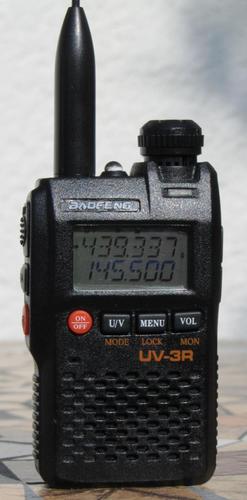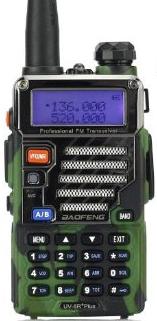Herwig online > UV-3R [ Deutsch ]
 Comments
on the Baofeng UV-3R
Comments
on the Baofeng UV-3R
A Review of the Handheld VHF/UHF Transceiver
The amateur radio rig UV-3R is manufactured in China. Its heart is the
one-chip transceiver RDA1846 from RDA Microelectronics in Shanghai which is a
software-defined radio (SDR) for 136-174 MHz (VHF) and 400-470 MHz (UHF). Two
PAs, one for VHF and one for UHF, produce a transmit power of 2 W. A 1-chip FM
radio for 87.5-108 MHz is also built into the rig.
The receiver does not use any ceramic or crystal filter. It is an IQ
direct-conversion receiver where a DSP (digital signal processor) is responsible
for selectivity. Problems of the first generation, like transmission of harmonic
signals, have been solved.
Great:
- The price of about 30 to 60 US$ (depending on the dealer and the included
add-ons) is unbeatable; it can be explained by the 1-chip transceiver concept
which minimizes the count of required components.
- The weight is only about 110 g (with Li-Ion accumulator but without
antenna). This is less than half of e.g. a Kenwood TH-F7. And the UV-3R is
noticeable smaller with just 47 x 81 x 21 mm≥.
- The receiver's sensitivity is more or less identical with the
conventionally built TH-F7 but it seems that signals come out of the noise more
quickly, probably due to the digital reception concept. For weak signals the
demodulator bandwidth is reduced automatically to improve readability.
- If the other station deviates a bit from the correct frequency, the
receiver's AFC (automatic frequency control) compensates this.
- CTCSS (often used by repeaters to avoid conflicts on the same channel) are
supported both by the transmitter and the receiver.
- During FM radio reception, the rig switches to amateur radio automatically
when the squelch opens, and it also switches back after a few seconds when it
closes again.
- The FM radio is very sensitive and works well even with an only 20 cm long
VHF/UHF antenna.
- The built-in speaker sounds very crisp, and the transmit audio is excellent
also.
- With a standby current of 75 mA only, the Li-Ion battery (3.8 V, 1500 mAh)
allows to operate the radio for up to 20 hours.
Problems:
- It is not possible to listen on VHF and UHF simultaneously because there is
only one receiver; it is misleading that both bands are displayed in two LCD
lines. Using the dual-watch function is no real alternative.
- Scanning (VFO or memories) is relatively slow compared e.g. to a Kenwood
TH-F7.
- You cannot lock out unwanted memory channels while scanning.
- The device does not have a numeric keypad, and consequently there is no
provision for sending DTMF tones; as a result, it is not possible to control
Echolink repeaters.
- It is not possible to copy a memory frequency into the VFO mode or to
delete it.
- The lowest volume level is still relatively loud which may be annoying in a
quiet environment. The beep when switching off the device is rather loud, too,
and when sending a 1750 Hz tone this can also be heard from the speaker.
- The transmit frequency range is not limited to the allowed amateur radio
bands; thus the rig may easily be abused by unauthorized users on frequencies
e.g. of law enforcement authorities, emergency services, or airplanes.
- The supplied manual is more or less catastrophic. It does not really
describe special functions (like W/N = Wide/Narrow, STE = tail-tone
elimination, RelayM = Repeater Sound Response) in an understandable way.
- Danger: Do not use the supplied charging base! It does not have a
full-charge detection; obviously only the emergency shut-down built into the
battery works in this case.
- Operation without the manual is near to impossible because many key
functions (see quick reference below) are not printed on the device.
Conclusion:
The device shows what is possible with a modern SDR/DSP concept: A small and
cheap VHF/UHF transceiver can be built with a minimum of components. If the
manufacturer offers rigs in the future which do not have all the limitations
mentioned above, established Japanese firms will get in trouble with their
conventional transceiver concept which is much more expensive due to the higher
component count.
Just as with other small handheld transceivers, especially on VHF the antenna
efficiency is limited by the fact that the tiny case is
not a proper counterpoise. An external antenna may give much better results
therefore.
UV-3R Quick Reference
- Switch transceiver on or off: Press ON/OFF for about 2 seconds. Battery
voltage is displayed when switching on.
- Switch between VFO and memory mode: Press U/V for 2 seconds.
- Change volume: Press VOL, dial new volume setting, then press VOL again
(or simply wait a few seconds).
- Switch UHF/VHF band: Press U/V shortly. The arrow in the display marks the
active frequency.
- Tune in MHz steps: Press F/A, tune; press F/A again to return to normal
step width.
- Scan in VFO or memory mode: Press F/A and then MENU.
- Stop scan: Press any key, e.g. F/A .
- Change scan direction: Pull dial knob up and turn to left or right for
down/up.
- Save VFO frequency (incl. CTCSS, repeater offset etc.) in memory: Press
F/A in VFO mode, dial memory (flashing), then press U/V to save.
- Change menu item: Press MENU, dial menu item, press U/V, dial new setting,
press U/V to save, then MENU to leave.
- Open squelch temporarily: Press VOL for 2 seconds; release key for normal
sequelch operation.
- Send 1750 Hz tone to open a repeater: While holding the PTT key, press VOL
for about one second..
- Lock or unlock current frequency: Press MENU for 2 seconds.
- Switch to FM radio: Press L/R for 2 seconds. The device will switch back
to the transceiver when the squelch opens.
- Switch lamp on/off: Press L/R; this works even if the transceiver is off.
- Alarm sound: Press F/A for 2 seconds. To stop the sound, press PTT.
- Reset to factory defaults: Switch device on while U/V key is pressed.
 Follow-up
model: UV-5R
Follow-up
model: UV-5R
In the follow-up model UV-5R Baofeng has added a numeric keyboard with DTMF
capability for Echolink repeaters. The circuit is still based on the RDA1846
transceiver chip, so most of the above is still true for the new model.
Harmonics suppression seems to be improved. The battery now has 7.4 V instead of
3.7 V, and the output power has doubled to 4 W. The knob on the top is no longer
used for changing the frequency but for on/off and volume. The UV-5R does have
its design flaws, though, e.g. you cannot use the up/down keys for resuming a
scan in a specific direction. Entering a frequency pair in a mmory channel for a
repeater is cumbersome - you have to enter the receive frequency first and then
the transmit frequency since the shift is not copied from the VFO. The optional
PC programming software is premature and hardly useful.
The device can receive and transmit everywhere from 136 to 174 MHz and from
400 to 520 MHz, so there are doubts if the CE/FCC plate on it is qualified. The
UV-5R is sold at a similar price as the UV-3R e.g. at Amazon - interestingly
without any notice who is allowed to use it on which frequencies. Some countries
like Switzerland have banned the import. In fact Internet message board entries
show that the now widespread device is often abused by non-licensed people on
various frequencies, perhaps sometimes simply resulting from ignorance.
Manufacturer:
Baofeng
 Comments
on the Baofeng UV-3R
Comments
on the Baofeng UV-3R Comments
on the Baofeng UV-3R
Comments
on the Baofeng UV-3R Follow-up
model: UV-5R
Follow-up
model: UV-5R